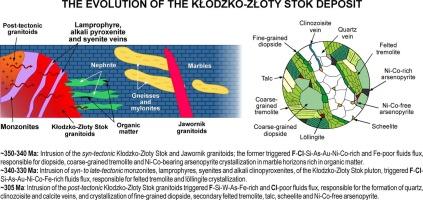苏德斯(欧洲Variscides,波兰西南部)Złoty Stok矿床:铁、砷、金和钨的来源,以及有机质在软玉形成和金属成矿中的作用
IF 3.6
2区 地球科学
Q1 GEOLOGY
引用次数: 0
摘要
中苏台德岩体Złoty Stok矿床赋存软玉、铁砷金矿化和少量钨矿化。软玉的白云岩成因表现为Cr (<14 ppm)、Ni (0.4-39.3 ppm)和Co (9.2-71.0 ppm)含量较低,尽管软玉中Fe2O3含量异常丰富(4.19-14.93 wt%),这可能是由于流体形成过程中镁铁质/超镁铁质侵入所致。矿床附近有两个与俯冲有关的、同时期的、同构造晚期的侵入套,但其中只有Kłodzko-Złoty Stok岩体参与了流体的形成,而Jawornik花岗岩类没有参与流体的形成。软玉F/Cl值(55.6 ~ 202.3)、δD值(- 95‰~ - 68‰)、δ18O值(δ18Otremolite +3.6‰~ +10.9‰、δ18Ocalcite +7.0‰~ +20.4‰)和δ37Cl值(- 0.4‰~ +0.6‰)跨度较大,反映了大理岩在3次流体流入事件下向矽卡岩和软玉的转变:1) Kłodzko-Złoty斯托克岩体(约340 Ma)花岗岩类流体中透辉石、透辉石和毒砂的析出;2)Kłodzko-Złoty斯托克岩体(约340 Ma)中富铁透辉石、透辉石、滑石和löllingite流体中与斜辉石岩、辉长岩、二长岩、煌斑岩和正长岩有关的透辉石、滑石和löllingite的析出;3)石英、方解石和斜辉石脉的形成和白钨矿、滑石和少量透辉石、透辉石和毒砂的析出;受Kłodzko-Złoty斯托克岩体(~ 305 Ma)后构造花岗岩类流体的影响。软玉和fe - as - au成矿作用在到达大理岩有机质富集层时优先从热液中析出,软玉和矽卡岩方解石δ13C值(- 16.0‰~ - 9.1‰)为负,表明有机质在白云岩相关软玉矿床的形成中起着至关重要的作用。本文章由计算机程序翻译,如有差异,请以英文原文为准。

The Złoty Stok deposit in Sudetes (European Variscides, SW Poland): Sources of Fe, As, Au and W, and the role of organic matter in the formation of nephrite and metallic mineralization
The Złoty Stok deposit in Central Sudetes hosts nephrite, Fe-As-Au-mineralization and minor W-mineralization. Dolomite-related origin of nephrite is evidenced by low Cr (<14 ppm), Ni (0.4–39.3 ppm) and Co (9.2–71.0 ppm) contents, although the nephrite is unusually rich in Fe2O3 (4.19–14.93 wt%) likely due to an involvement of mafic/ultramafic intrusions in fluids formation. Two subduction-related, coeval, syn- to late-tectonic intrusions suites are adjacent to the deposit, but, of them, only the Kłodzko-Złoty Stok pluton was involved in the fluids formation, whereas Jawornik granitoids were uninvolved. A broad span of nephrite F/Cl (55.6–202.3), δD (−95 ‰ to −68 ‰), δ18O (δ18Otremolite +3.6 ‰ to +10.9 ‰, δ18Ocalcite +7.0 ‰ to +20.4 ‰) and δ37Cl (−0.4 ‰ to +0.6 ‰) values, reflect a transformation of marbles into skarns and nephrite under three fluid influx events: 1) tremolite, diopside and arsenopyrite precipitation from fluids derived from granitoids of the Kłodzko-Złoty Stok pluton (ca. 340 Ma), 2) Fe-enriched tremolite and diopside, talc and löllingite precipitation from fluids, related with clinopyroxenites, gabbros, monzonites, lamprophyres and syenites, of the Kłodzko-Złoty Stok pluton (ca. 340 Ma), 3) quartz, calcite and clinozoisite veins formation and precipitation of scheelite, talc and minor tremolite, diopside and arsenopyrite, under the influence of fluids from post-tectonic granitoids of the Kłodzko-Złoty Stok pluton (∼305 Ma). Nephrite and Fe-As-Au-mineralization preferentially precipitates from hydrothermal fluids when they reach an organic matter-rich horizon in marbles, as evidenced by highly negative δ13C values (−16.0 ‰ to −9.1 ‰) of calcite from nephrites and skarn, suggesting a crucial role of organic matter in the formation of dolomite-related nephrite deposits.
求助全文
通过发布文献求助,成功后即可免费获取论文全文。
去求助
来源期刊

Ore Geology Reviews
地学-地质学
CiteScore
6.50
自引率
27.30%
发文量
546
审稿时长
22.9 weeks
期刊介绍:
Ore Geology Reviews aims to familiarize all earth scientists with recent advances in a number of interconnected disciplines related to the study of, and search for, ore deposits. The reviews range from brief to longer contributions, but the journal preferentially publishes manuscripts that fill the niche between the commonly shorter journal articles and the comprehensive book coverages, and thus has a special appeal to many authors and readers.
 求助内容:
求助内容: 应助结果提醒方式:
应助结果提醒方式:


